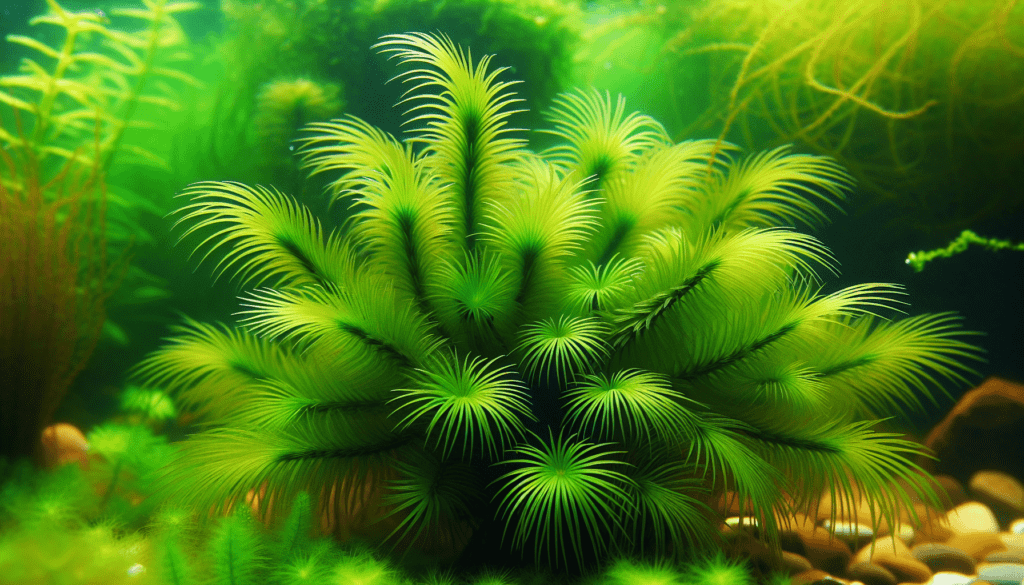In this scholarly discourse, you are invited to embark on an exploration of the common hornwort, a fascinating and significant aquatic plant species. Throughout this piece, you are guided not merely by the question of what this species represents, but also by the profound ecological implications it holds. Your intellectual journey will encompass the taxonomy, morphology, and ecological significance of the hornwort, thereby providing a comprehensive understanding of its role within aquatic ecosystems. As you navigate the labyrinth of information, you can expect to gain not only comprehensive knowledge on this subject, but also, refined and valuable insights into the complexity and richness of our aquatic ecosystems. Prepare to expand your botanical horizon, while also deepening your appreciation for life under water.

Overview of Common Hornwort
In the vast world of aquatic plants, Common Hornwort, with its unique resilience and ability to thrive in diverse conditions, holds a significant place. It is a perennial plant, known to adapt effortlessly to changing environments and serve as a habitat and food source for various aquatic creatures.
Definition of Common Hornwort
Common Hornwort is a submerged, free-floating aquatic plant that naturally grows in water bodies, be it still or flowing. It has a long, slender stem with whorled, feathery, and horn-like leaves, giving it the name ‘Hornwort.’ The scientific name of Common Hornwort is ‘Ceratophyllum demersum.’
Scientific classification of Common Hornwort
Common Hornwort belongs to the Ceratophyllum family, which is the sole representative of the Ceratophyllaceae family in the Plantae kingdom. The genus Ceratophyllum derives its name from the Greek words ‘keras’ meaning horn and ‘phyllon’ meaning leaf, perfectly embodying the prominent features of this species.
Physical Characteristics of Common Hornwort
Common Hornwort possesses a blend of physical attributes that help it survive under diverse conditions, spread rapidly and serve a significant role in aquatic ecosystems.
Description of the plant’s external features
Common Hornwork has long, branching, and hollow stems. The leaves grow in whorls around the stem, resembling the appearance of a green feather or a submerged fir tree. The lack of roots is a characteristic feature of this plant which allows it to freely float in water bodies.
Growth and development of Common Hornwort
This plant exhibits robust growth, developing well in various light conditions. It tends to become denser with increased light exposure. The growth is not limited to specific seasons but occurs all year round, facilitating the widespread distribution of the plant.
Size and color variations of Common Hornwort
Common Hornworts can grow up to 10 feet long in optimum conditions, although the typical growth ranges from 1 to 3 meters. The stems, initially bright green, darken with age. Under stress conditions, the plant might acquire a reddish hue.
Common Habitats of Common Hornwort
Common Hornworts are cosmopolitan in nature, indicating their wide-spread availability across various habitats.
Typical water environments where the plant thrives
These plants are predominantly found in freshwater bodies like ponds, lakes, reservoirs, and streams. They endure varying water conditions, from stagnant to flowing, and from clear to turbid.
Geographical distribution of Common Hornwort
Common Hornwort is spread globally, from North and South America to Asia, Africa, and Australia. It thrives in diverse climates, from tropical to temperate regions.

Cultivation and Care of Common Hornwort
Both novice gardeners and expert aquarists applaud the Common Hornwort’s ease of propagation and maintenance.
Planting procedure and tips for Common Hornwort
Being a free-floating plant, it does not require a defined planting procedure. Simply adding a piece of the plant to an aquatic environment is generally enough for its establishment and growth.
Preferred water conditions and temperatures
Common Hornwort adapts to different water conditions, although soft, slightly acidic to neutral water is ideal. It flourishes best at temperature ranges between 15 to 30 degrees Celsius.
Maintenance and pruning of Common Hornwort
Minimal maintenance is required for these plants. Periodic pruning helps control their rapid growth, prevents clutter, and retains the aesthetic appeal of aquariums or ponds.
Reproduction and Life Cycle of Common Hornwort
Common Hornworts are fascinating with their reproductive abilities and life cycle.
Understanding the plant’s reproductive system
Common Hornwort reproduces through vegetative fragmentation, a process where new plants form from the fragments of the parent plant. It does also reproduce sexually, which includes producing seeds after fertilization.
Stages of life cycle of Common Hornwort
The plant begins its life as a tiny fragment or a seed and gradually grows, branching into an extensive submerged bush. Depending on the environmental conditions, the plants may either continue to grow or may decline during extreme winters or summers.
Use of Common Hornwort in Aquariums
Common Hornwort is favored in aquariums due to its aesthetic, ecological, and welfare advantages.
Benefits of including Common Hornwort in fish tanks
These plants serve as natural filters, absorbing excess nutrients and thus, controlling algal growth. They also provide habitat and breeding grounds for aquatic creatures and contribute to their well-being by releasing oxygen into the water.
Tips for planting and caring for Common Hornwort in aquariums
Simply floating the plant in the water would do the job since it does not demand anchoring to substrates like other aquatic plants. Regular water changes, maintaining optimal temperature, and occasional pruning would ensure its flourishing growth.
Common Hornwort in Ponds
Common Hornwort is crucial in maintaining the ecological balance in ponds.
Role of Common Hornwort in pond ecosystems
This plant plays a critical functional role in maintaining water quality by absorbing pollutants. It also provides shelter and food to numerous organisms, hence preserving biodiversity.
Considerations for introducing Common Hornwort in pond environments
Before introducing these plants, ensuring the pond conditions, like water temperature and quality, would lead to better acclimatization and growth of the plant.
Threats and Diseases of Common Hornwort
Like any organism, Common Hornwort also faces challenges that threat its survival and health.
Common pests and diseases affecting Common Hornwort
Common issues seen in Common Hornwort include blackening or browning of stems, usually due to poor water quality or deficient light conditions. Pest infestations like snails or insect larvae are also common.
Treatment options for sick Common Hornwort
Correction of water conditions and addition of plant nutrients helps in plant recovery. To control pest infestation, manual removal of pests or careful use of pesticides can be adopted.
Common Hornwort and Wildlife
Common Hornwort shares an empirical connection with the wildlife dwelling in and around the water bodies it inhabits.
Information about wildlife species that interact with Common Hornwort
Fish, snails, crayfish, and insects are among the numerous organisms that interact with these plants. They serve as feeding grounds for herbivores and nesting spots for small fish and invertebrates.
Benefits of Common Hornwort for water-dwelling creatures
Common Hornwort offers a multitude of benefits to aquatic creatures by offering food, serving as a nursery for juvenile stages, and providing shelter from predators.
Conservation and Environmental Impact of Common Hornwort
This plant holds significant conservation value due to its environmental impact and influence on aquatic health.
Role of Common Hornwort in water bodies’ health
These plants play a crucial role in nutrient cycling, control of algal blooms, and maintaining water quality, hence contributing substantially to the health of water bodies.
State of conservation and threats to Common Hornwort populations
Being a common aquatic plant, Common Hornwort does not fall under any threat category currently. However, water pollution, habitat destruction, and invasive species pose potential threats to this plant population.
The Common Hornwort, besides its ecological importance, also offers incredible aesthetic value to aquatic gardens. This hardy plant, with its majestic green sprigs dancing in water currents, surely brings life and vigor to any water body it conquers.
